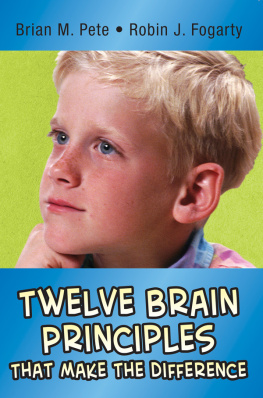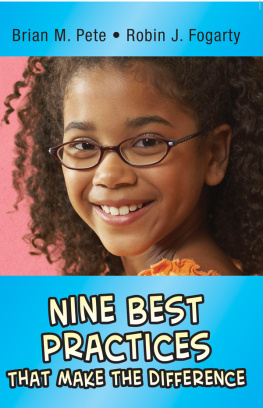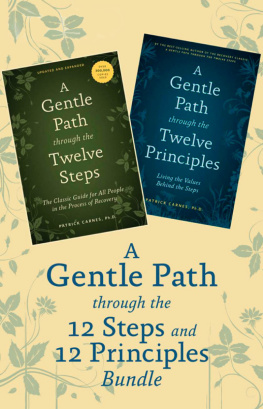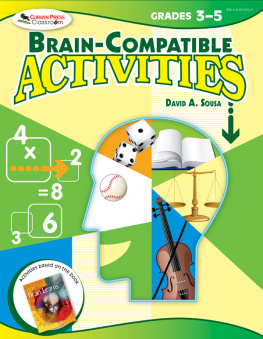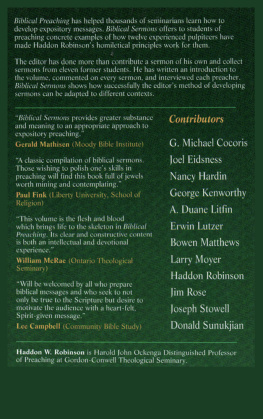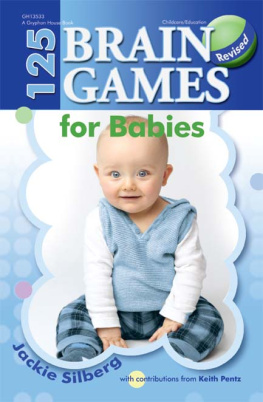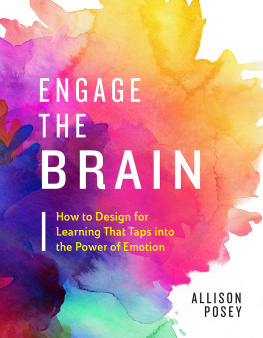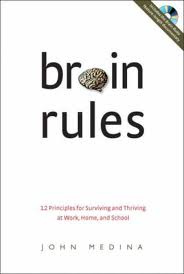In A Nutshell
series
The Hungry Brain: The Nutrition/Cognition Connection
Susan Augustine
inFormative Assessment: When Its Not About a Grade
Robin J. Fogarty and Gene M. Kerns
The Adult Learner: Some Things We Know
Robin J. Fogarty and Brian M. Pete
How to Differentiate Learning: Curriculum, Instruction, Assessment
Robin J. Fogarty and Brian M. Pete
A Look at Transfer: Seven Strategies That Work
Robin J. Fogarty and Brian M. Pete
Close the Achievement Gap: Simple Strategies That Work
Brian M. Pete and Robin J. Fogarty
Nine Best Practices That Make the Difference
Brian M. Pete and Robin J. Fogarty
Twelve Brain Principles That Make the Difference
Brian M. Pete and Robin J. Fogarty
Data! Dialogue! Decisions! The Data Difference
Brian M. Pete and Catherine A. Duncan
Cooperative Learning: A Standard for High Achievement
R. Bruce Williams
Higher Order Thinking Skills: Challenging All Students to Achieve
R. Bruce Williams
Multiple Intelligences for Differentiated Learning
R. Bruce Williams
Copyright 2003 by Corwin Press
First Skyhorse Publishing edition 2015.
All rights reserved. No part of this book may be reproduced in any manner without the express written consent of the publisher, except in the case of brief excerpts in critical reviews or articles. All inquiries should be addressed to Skyhorse Publishing, 307 West 36th Street, 11th Floor, New York, NY 10018.
Skyhorse Publishing books may be purchased in bulk at special discounts for sales promotion, corporate gifts, fund-raising, or educational purposes. Special editions can also be created to specifications. For details, contact the Special Sales Department, Skyhorse Publishing, 307 West 36th Street, 11th Floor, New York, NY 10018 or .
Skyhorse and Skyhorse Publishing are registered trademarks of Skyhorse Publishing, Inc., a Delaware corporation.
Visit our website at www.skyhorsepublishing.com.
10 9 8 7 6 5 4 3 2 1
Library of Congress Cataloging-in-Publication Data is available on file.
Print ISBN: 978-1-63450-359-4
Ebook ISBN: 978-1-5107-0131-1
Contents
Acknowledgments
On a theoretical note, of all the information available about how the brain works, perhaps one of the most insightful pieces for educators is the meta-analysis of the research on the brain and learning by Renate and Geoffrey Caine. The twelve principles that govern how the brain learns and remembers provide an invaluable guide for instructional decision making. For their magnificent contribution and generous spirit, we are grateful to the Caines.
On a more practical note, we are grateful to the many hearts, hands, and minds who have made this book possible, especially Dara Lee Howard, who has provided organization, editing and, at times, some writing, and Jon Hensley, who has created a striking cover. To all, our heartfelt thanks.
Brian M. Pete
Robin J. Fogarty
Dedication
With love,
to Maple Ann,
strong and presiding,
like the maple tree
on Maple Hill Road
Introduction
There is the cartoon about the little boy who brags to his friend about how he has taught his dog, Stripe, how to whistle. Subsequently, he replies to the Doubting Thomas friend, who points out that Stripe is not whistling, I said I taught him. I didnt say he learned it. To the authors, this picture is worth a thousand words, as the saying goes. It epitomizes the entirety of the teaching/learning process. Teachers teach! But students must learn! These are two very different sides of the same coin.
This book is part of a two-book series. The first book in the set is titled Nine Best Practices That Make the Difference and focuses on the teaching part of the teaching/learning process. This book, Twelve Brain Principles That Make the Difference , focuses on the learning part of the teaching/learning equation.
More specifically, this book is about how the brain learns best and all the things teachers can do to facilitate the learning part of the teaching scene. This Nutshell presents a unique organization of Renate and Geoffrey Caines twelve brain principles. The twelve principles are arranged in four specific quadrants as shown in . Each quadrant speaks to a particular aspect of the high-achieving classroom and highlights how instructional decisions are governed by the twelve principles.
| Climate for Learning | Skills of Learning |
| Challenge/Threat | Parts/Whole |
| Emotions/Cognition | Spatial/Rote |
| Focused/Peripheral | Parallel Processing |
| Interactions With Learning | Learning About Learning |
| Physiology | Meaning |
| Brain Uniqueness | Patterning |
| Social/Experience | Conscious/Unconscious |
Figure Intro.1. Four quadrants of brain principles.
Quadrant 1 addresses the environment for learning, stressing both the emotional climate and the enriched environment. This quadrant includes three complementary principles that foster a climate for optimal learning: Principle 1 addresses the concept of challenge engaging the mind; Principle 2 discusses the link between emotions and cognition; and Principle 3 highlights the learning environment and its role in the focused attention and peripheral perception of students.
Quadrant 2 speaks to the standards of learning and the context, content, and process skills for which each K-12 teacher is accountable. Embedded in the concept of necessary concepts and skills for various grade levels or disciplines are the three accompanying principles: Principle 4, which notes that the brain learns parts and whole simultaneously; Principle 5, which documents the rote and spatial memory systems; and Principle 6, which discusses the role of the brain as a parallel processor. All three of these principles speak to the teaching techniques that foster memory and learning.
Quadrant 3 encompasses the concept of hands-on learning that is constantly and continually facilitated as an integral part of any lesson. Included in this quadrant are three principles that dictate ways needed to address the eager learner: Principle 7, which highlights the need for being aware of the entire physiology in the learning setting; Principle 8, which acknowledges the difference in the structure and chemistry of each and every brain and pushes the implications of that diversity for classroom teachers; and Principle 9, which explores the concept of the social brain and how it learns easily when embedded in experiences. All three of these principles inform the practice of hands-on learning.
Quadrant 4 focuses on reflective thinking and how the brain makes meaning, stores information, and retrieves needed memories. Again, three principles make up the essence of this quadrant. Principle 10 clarifies the nature of the brain to seek meaning; Principle 11 discusses the role of patterning in memory and learning; and Principle 12 reminds the teacher of the need for processing timedown timefor the brain to complete its deep processing of new input. All three principles illuminate the idea of how the brain makes sense of the world. All three speak to the practices of the skillful teacher.
How the Book Is Organized
The book is organized in four parts that parallel the four quadrants: Climate for Learning, Skills of Learning, Interactions With Learning, and Learning About Learning. Within each part, each principle in the quadrant is fully explained. To start, each principle is introduced by unpacking the language through the use of synonyms. In addition, each of the principles is discussed through the use of three distinct parts: A Story to Tell, Things You Need to Know, and A Tiny Transfer to Try.

